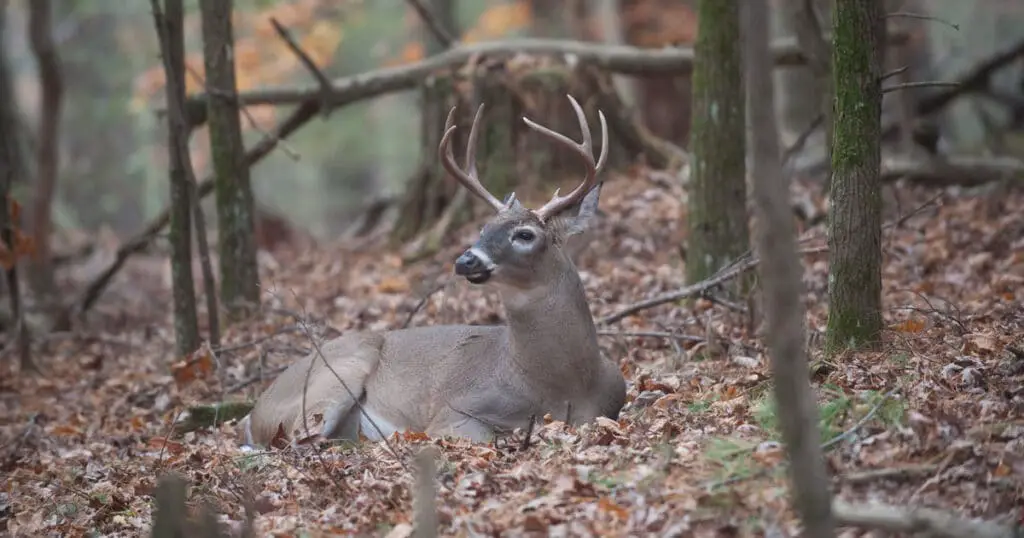Whether you’re a hunter, or are simply curious and want to know where do deer sleep at night, you might be surprised to learn that deer may not bed down at night the way you would expect. Deer are crepuscular animals that are most active during the twilight hours just before dawn and just after sun-down, so while they may sleep intermittently at night, they are probably bedding down more during the day.
Deer usually sleep during the day. They sleep in their bedding locations. It’s rare for a deer to sleep for extended periods at night. If it does, it will sleep in its bedding area.
Let’s learn about deer behavior patterns when it comes to sleep. We will learn about the factors that go into a deer’s decision-making when it’s figuring out where to bed down and sleep.
Where Do Deer Bed Down at Night?
Most deer primarily sleep during the day, rarely doing so at night. There are several factors that a deer must consider when deciding where to bed down and sleep. Examples include protection from the weather, access to food and water, and safety from predators.
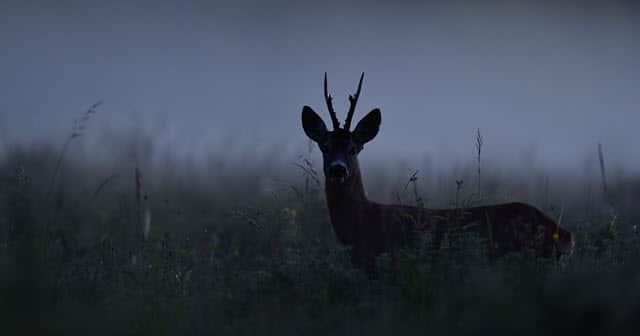
There are certain kinds of locations that are most common for deer bedding spots. All of them have one thing in common: deer perceive them as being relatively secluded and safe, and they provide cover and a sense of security.
The exact environments deer find most attractive for bedding areas often depends on the region and features of the terrain.
In general, bedding areas range widely. Just a few examples of places where deer may choose to sleep include:
- orchards,
- flats, and
- fields with plenty of cover.
Do Deer Bed Down in the Same Place Every Night?
As mentioned earlier, deer don’t usually sleep at night. They generally sleep only during the day. However, whenever they sleep, they will sleep in a bedding area. Deer like to stick with what they know whenever possible.
It can be difficult for a deer to find a great bedding area, so they will often retain the same one over long periods.
Deer always look for bedding spots with easy routes for getting in and out. As a prey animal, deer never want to feel trapped. As it takes time to find decent bedding areas, deer will usually stay with one they already like.
What Does a Deer Bed Look Like?
A deer bed is quite simple. It’s indicated by an oval-shaped mark on the ground. This is where the deer gets comfortable, relaxes, and sleeps.
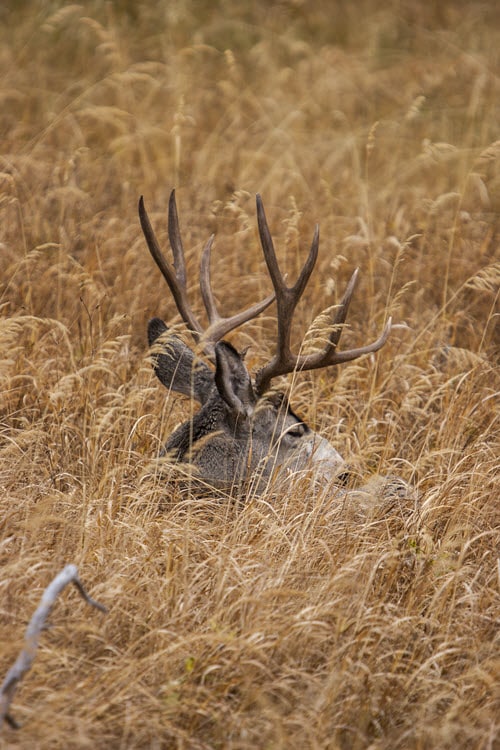
The bed may be in brush, grass, or even just dirt. In many cases, you see several deer beds in one bedding area. This is because deer often sleep in groups called herds, partly because there is greater safety in numbers.
The more deer that are there, the more likely it is that predators will be detected before it’s too late.
Do Deer Sleep Lying Down or Standing Up?
Contrary to what you may think, deer don’t usually sleep standing up. They lie down in a way similar to cats. In other words, they can tuck in their lets and get curled up.
If it wants to, a deer can sleep standing up. The way deer sleep makes this possible. As we’ve learned elsewhere, deer only sleep in extremely short segments between just 30 seconds and a couple of minutes.
They will alternate between periods of sleep and periods of being awake during their rest. If a deer feels especially under threat but needs to sleep, it may well sleep standing up.
Where do Whitetail Deer Sleep at Night?
Whitetail deer most often sleep during the day. While they may occasionally sleep a little bit at night, this is the exception rather than the rule.
Deer like to be at their most alert at night, partly because that is also when many predators are active. This isn’t a good time for prey, such as deer, to relax.
Deer go to their bedding areas to sleep. These bedding areas are where deer bed down and relax, and they tend to have excellent cover and are easy to enter and escape from.
How Season and Weather Impact Where Deer Sleep?
In the cool and cold weather of the fall and winter, deer most often venture further into deep woods. They want somewhere with good protection from harsh weather but they need a bit of direct sunlight, too.
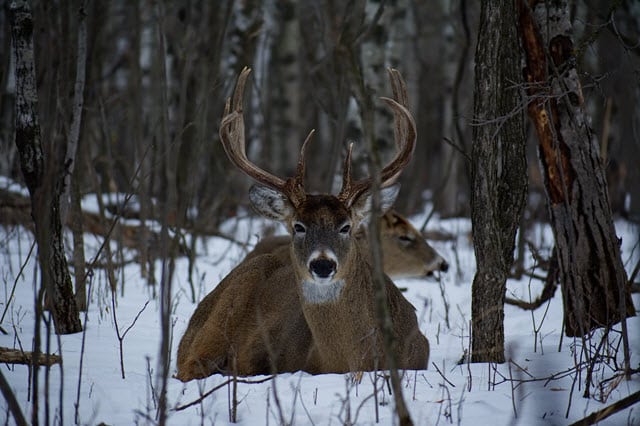
In the spring and summer months, deer are especially likely to favor bedding areas near waterways. These animals love a breeze and fresh air. Being near a waterway not only makes drinking water more readily accessible, it also creates a cool spot in the hot summer.
Experts believe that bucks always sleep in different places in the cool and cold months than they do in the summer and spring.
During the hot summer months, bucks, like other deer, enjoy places with a breeze and near the water. In the winter, bucks want to find side cover in a high ground location.
What Do Deer Look for in Bedding Areas?
There are a few factors deer consider when choosing bedding areas. A deer will seek bedding areas with three qualities:
- Easy to exit and enter
- Free of potential threats
- Cover or camouflage capabilities
If possible, deer prefer choosing bedding areas in close proximity to food sources. Pressure from hunting also often affects where a deer will, and will not, sleep.
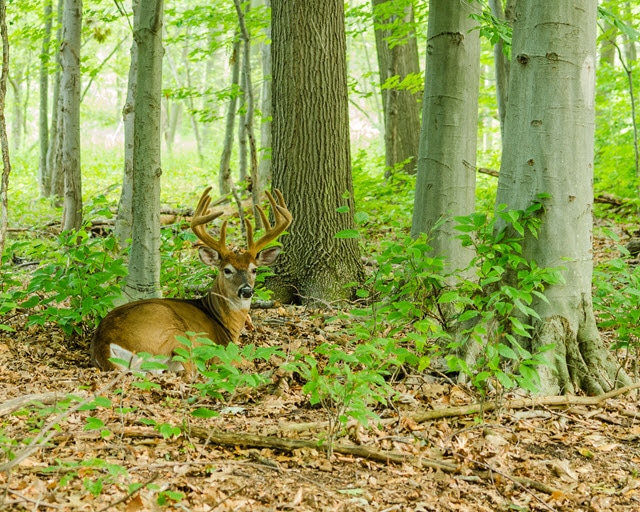
When deer know or sense that there is hunting in the area, it will choose bedding spots that are further away from activity, with more cover.
Where Do Deer Sleep When it Rains?
Rain doesn’t usually have any effect on how deer behave, how much they move, or what they do. As a result, most rainy weather won’t cause any change in where deer bed down. These animals will probably stick to their usual bedding spots.
The only exception is if there is a serious rainstorm that is causing the animal distress or interfering with its activities. If this happens, deer may look for areas with more cover.
Do Deer Sleep Like Humans?
No, deer sleep in a different way than humans. When we think of sleep, we tend to think of sleeping all the way through several hours. Deer are different, mainly because they are prey animals.
Deer never have a deep sleep. Generally, deer will sleep a maximum of a few minutes at a time. One sleep span may be as short as 30 seconds.
As you might guess, deer sleep consists of cyclical dozing and waking. This makes these animals safer as prey animals. If they slept like we do and wouldn’t immediately wake up when a predator may be near, deer would be incredibly vulnerable.
Deer often sleep with their eyes closed, but they can keep their eyes open if they want to. This is one of the most significant differences between deer sleep and human sleep.
How Do Deer Detect Predators During Sleep?
Deer keep up high levels of hearing and detecting smell when they’re asleep. Even when a deer is sleeping, its ears will stay alert. They swivel around regularly, and they will detect absolutely any change in the environment.
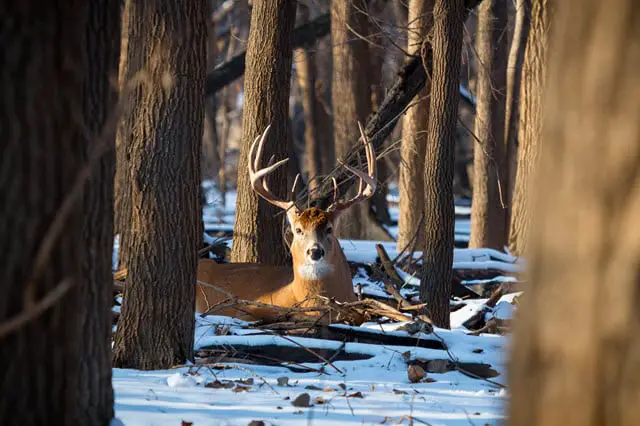
Deer are also able to detect the smell of danger (for example, predators) while they’re asleep.
The most remarkable feature of deer sleep is how these animals are able to stay so alert and detect predators even during this most vulnerable time.
What Do Deer Do in their Bedding Areas?
Sleep isn’t the sole purpose of having a bedding area. In fact, approximately 70 percent of a deer’s life is spent in a bedding spot.
As ruminants, deer spend a lot of time chewing cud and relaxing in their bedding areas. They also groom. Deer in the same bedding area will closely bond and socialize.
Final Thoughts
Deer usually sleep during the day, not at night. When they do sleep at night, they usually stick to their usual bedding area. Deer look for cover, an easy escape route and entrance, and freedom from threat in their bedding areas.

